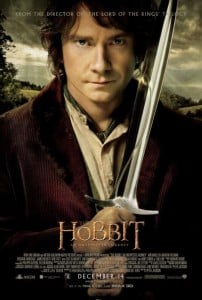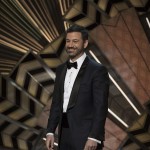 I can relate to Bilbo Baggins. He’s a quiet, peace-loving hobbit who has no interest in adventure because adventure makes you late for dinner. It takes you away from comfort and throws you into all kinds of unknown, possibly dangerous situations. Then again, moving beyond comfortable boundaries to experience more of what the world has to offer can be appealing. It can even be a calling.
I can relate to Bilbo Baggins. He’s a quiet, peace-loving hobbit who has no interest in adventure because adventure makes you late for dinner. It takes you away from comfort and throws you into all kinds of unknown, possibly dangerous situations. Then again, moving beyond comfortable boundaries to experience more of what the world has to offer can be appealing. It can even be a calling.
That’s the choice Bilbo (Martin Freeman) faces in Peter Jackson’s new film “The Hobbit: An Unexpected Journey,” based on J.R.R. Tolkien’s popular book. This prequel to the cinematic epic, “Lord of the Rings,” promises to be epic itself. Jackson, who directed the previous films, is turning “The Hobbit” into a trilogy despite it’s only being a single book. He plans to add in storylines from additional material Tolkien wrote that fills in some of the blanks of the story.
The movie’s subtitle, “An Unexpected Journey,” sums up how Bilbo gets involved in an adventure with Gandalf the wizard (Sir Ian McKellen) and the 13 voraciously hungry dwarves who arrive at his hobbit hole uninvited. Many years ago, the dwarves lost their Misty Mountain kingdom of Eredor and all their gold to the vicious dragon Smaug, who now hordes it all to himself. Gandalf, who met Bilbo as a child, invites the hobbit on their quest to reclaim the dwarves’ home because he thinks the expedition party, led by Thorin Oakenshield (Richard Armitage), needs a burglar who is small and can sneak into Erebor without attracting Smaug’s attention.
Intrigued, Bilbo considers the offer despite the journey possibly resulting in his “laceration, evisceration or incineration.” The dwarves’ purpose awakens in him a sense of adventure, along with a perhaps still-unrecognized feeling that he wants to do something meaningful.
In his book “Bilbo’s Journey: Discovering the Hidden Meaning in The Hobbit,” author Joseph Pearce examines the inherent Christian worldview Tolkien brought to his writing. He says, “In Christian terms, Bilbo Baggins is dedicated to the easy life and would find the prospect of taking up his cross and following the heroic path of self-sacrifice utterly anathema. The unexpected party at the beginning of the story…is, therefore, a necessary disruption. It is the intervention into his cozy life of an element of inconvenience or suffering which serves as a wake-up call and a call to action. Gandalf introduces the reluctant Bilbo to Thorin Oakenshield and the other dwarves in order to prompt him into an adventure, the purpose of which is ostensibly the recovery of the dwarves’ treasure but also, on the moral level at which the story works, the growth in wisdom and virtue, through suffering and sacrifice, of Bilbo himself.”
As the expedition party encounters trolls, goblins and orcs, there are plenty of instances of life-threatening danger. Though Bilbo is scared, he uses his wits and screws up his courage when he and his companions need it most.
The virtue of courage comes into play in a unique way in the film’s strongest and most entertaining sequence: Bilbo’s confrontation with Gollum (Andy Serkis), the creature who possesses a special ring that, unbeknownst to him, is the “one ring to rule them all” that will motivate what happens in “Lord of the Rings.”
Earlier in the story, Bilbo was discussing courage with Gandalf, who explained to him, “True courage is not about when to take a life, but when to spare one.” In the interaction with Gollum, Bilbo is faced with something that is literally willing to eat him for dinner. But when given the opportunity to kill Gollum, Bilbo recalls Gandalf’s words, feels pity for this vile, desperate creature, and restrains himself. Not only has he practiced courage here, but also mercy.
Even though “The Hobbit” is a lighter, more humorous story than “Lord of the Rings,” it still includes an undercurrent about the power of evil. It’s particularly potent if you’re familiar with what happens in those subsequent stories.
Gandalf, for instance, senses that something is amiss in Middle-Earth, “that always evil will look to find a foothold in this world.” But Middle Earth has enjoyed 400 years of peace, so everyone thinks he is over-reacting, that a few strange and dangerous incidents are simply aberrations. There’s something darkly humorous about this idea because it comes from Saruman (Christopher Lee), who eventually becomes a power-mad villain. Here, however, he is still the good, though naive Saruman – at least I think so. It’s hard to tell with Christopher Lee who always looks menacing.
This idea of evil lying in wait was also likely influenced by the fact that Tolkien witnessed World War I, which was called “the war to end all wars.” Then he saw Hitler’s rise and the catastrophic loss of life in World War II. Though Tolkien believed in the power of the common man – represented here by hobbits – to change the world for the better, his insight about human nature’s potential to engage in destruction was also pretty sharp.
For fans of “Lord of the Rings,” one of “The Hobbit’s” strongest features is that it brings back many familiar characters like Gollum and Saruman. Also along for the ride are Elrond (Hugo Weaving), Galadriel (Cate Blanchett), Frodo (Elijah Wood), and even Ian Holm as an older Bilbo. It’s like visiting with old friends again and getting to know more about their pasts.
The newer characters are a treat as well, especially the troop of 13 dwarves. While I can’t say I remember each of their names, they each have distinct enough looks and personality traits that you can differentiate who’s who and enjoy them as individual characters. Richard Armitage as Thorin is the standout as the warrior king who is driven by past defeats and the deaths of family members. Though arrogant at times, he’s the kind of leader you both fear and respect. Armitage has the gravitas to pull this off.
My primary negative comment about the story is that the battle scenes can be a little long and unrelenting for my tastes. I tend to prefer the more story-driven, character moments. Of course, there would be no story without the battles and they’re presented in a captivating way. I just would have tweaked them to be a little shorter. But I’m guessing I’ll be in the minority on that one.
My other issue is with the look of the film which was shot in 48 frames per second (twice the usual rate), making it the most crystal clear picture you’ve ever seen on the big screen. To me, it’s so smooth, crisp and clear that I found it distracting, even phony looking, despite the fact that it’s supposed to make the movie feel more real. At a press conference about “The Hobbit,” director Peter Jackson said the only people the new look bothers is those over age 20. Since I am definitely over 20, that could explain my reaction. I kind of got used to it by the movie’s end, but I’m still not a fan.
In terms of story, content and execution, however, I am a fan of “The Hobbit.” It offers a vivid depiction of good vs. evil, tells a compelling story, and incorporates the moral and Christian subtext for which Tolkien is known. In other words, “The Hobbit” is well-worth the journey out of your comfortable hobbit hole and into a theater near you.
UPDATE: For a mother’s take on “The Hobbit,” check out Lisa Hendey’s post.












